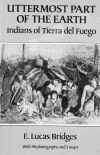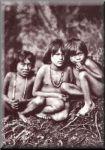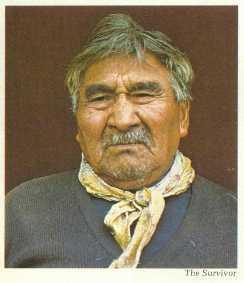|
| |
Kanu Links
The Patagonian Canoe

Extracts from E. Lucas Bridges book "Uttermost Part of the
Earth. Indians of Tierra del Fuego" 1949, reprinted by Dover Publications,
Inc (New York, 1988). The book is now out of print.
Lucas Bridges was a son of Thomas Bridges, a missionary who had the
courage to establish a mission at Ushuaia in 1871, at a time where the Yamanas still lived
their traditional lives. Lucas was born there in 1874, and as he grew up, played and
worked with the natives, first the Yamanas, later the Onas. He spoke their languages and,
as adult, witnessed the decline and extinction of these tribes. Near the end of his
colourful life, he sat down to write an eye-witness account that is both fascinating and
enlightening. I am typing out paragraphs that relate to the canoes and life of the
Yamanas.
 | p.61: (a reference to the people that lived to the west of the
Yamanas) The Alacaloof were a tribe of canoe Indians. They lived almost entirely on birds,
seal, fish and limpets. As their neighbors (the Yamanas) they made bark canoes. They also
made dug-outs, which were much larger than the bark canoes. Father found one that measured
twenty-nine feet in length and well over three feet in depth. For these the Alacaloof used
not only paddles, but also oars of primitive design, with wooden row-locks....Adventurers,
both the Alacaloof and Yamanas, had passed around the Brecknock Peninsula in their canoes,
and inter-marriages between the two tribes occurred from time to time.
|
 | p.63: There was a fair division of labour between the sexes. The men
gathered fuel and fungus for food, while the women cooked, fetched water, paddled the
canoes and fished. The men tended the fires, made and mended the canoes and prepared
material for them. They also attended to the hunting - otter, seal, guanaco, foxes and
birds - and speared the large fish. Being in charge of the canoes - for it was only on
long journeys, or when in a hurry, that the men helped with the paddles - the women were
also good swimmers, but it was a rare thing to find a male Yamana who could swim. The
women were by no means slaves, for what they caught was their own. The husband used only
what the wife gave him, and she did not ask his permission before making gifts to her
friends.
Members of this tribe often lived in places where for many miles there were no beaches on
which it was possible to haul up their canoes. They were compelled, therefore, to anchor
them off the rocks in the best shelter to be found. This anchoring was done by the women.
After the canoe was unloaded and the husband had gone up into the forest to collect fuel
for the fire, the wife would paddle off in the canoe a few fathoms into the thick kelp (a
large species of seaweed), which makes a splendid breakwater. She would grasp a handful of
the kelp's rope-like branches and secure them to the canoe, which was thus safely anchored
by their roots, then slip into the water, swim ashore and hasten to the fire to dry and
warm herself.
The Yamana women swam like a dog and had no difficulty getting through the kelp....They
learnt to swim in infancy, and were taken out  by their mothers in order to get them
used to it. In winter, when the kelp was coated with a film of frost, a baby girl out with
her mother would sometimes make pick-a-back swimming difficult by climbing onto her
parent's head to escape the cold water and frozen kelp. by their mothers in order to get them
used to it. In winter, when the kelp was coated with a film of frost, a baby girl out with
her mother would sometimes make pick-a-back swimming difficult by climbing onto her
parent's head to escape the cold water and frozen kelp.
|
 | p.65: Fires were also kept going in the canoes when they were in use.
There was little danger. Seawater leaked through the seams and kept the interiors of the
canoes perpetually damp. The fires were built on little heaps of sand and moist turf in
the centres of the canoes. On reaching the night's camping-ground after a day in the
canoes the Yamanas would carry embers or blazing torches ashore. When they re-embarked the
following morning, or if women went off for a few hours' fishing, fire was carried back to
the canoes. Thus, except when men hunting and passed the night away from home, it was
rarely necessary to kindle a new fire.
There is another interesting point about the fires of the Fuegian Indians. In the the
numberless sheltered nooks round the shores, at points where canoes could safely be beached, were
Yamana families living in their wigwams. If a distant sail appeared, or anything else
occurred to startle those who had remained at home, they would send out a warning to those
away fishing by piling green branches or shrubs on the wigwam fire. At the sight of the
black signal smoke the fishers would hurry back home. The early explorers of that
archipelago would see the countless columns of smoke at short intervals for miles along
the coast. nooks round the shores, at points where canoes could safely be beached, were
Yamana families living in their wigwams. If a distant sail appeared, or anything else
occurred to startle those who had remained at home, they would send out a warning to those
away fishing by piling green branches or shrubs on the wigwam fire. At the sight of the
black signal smoke the fishers would hurry back home. The early explorers of that
archipelago would see the countless columns of smoke at short intervals for miles along
the coast.  This
is doubtless the reason why they named those regions Tierra del Fuego. It is possible,
however, that some tract of grassland on the northern part of the island may have been
seen burning. This
is doubtless the reason why they named those regions Tierra del Fuego. It is possible,
however, that some tract of grassland on the northern part of the island may have been
seen burning.
|
 | footnote on p.77: The Fuegians obtained nearly all their supplies of
whale meat and blubber from stranded whales, which had either drifted ashore after falling
victim to killer whales in deep water, or had been stranded in their desperate efforts to
escape those fierce creatures. My father heard of only one occasion where the Yamana
actually did a whale to death. A whole fleet of canoes was used, and the attack lasted
over twenty-four hours.
|
Click here to get back to the Patagonian Canoe web page
|


 by their mothers in order to get them
used to it. In winter, when the kelp was coated with a film of frost, a baby girl out with
her mother would sometimes make pick-a-back swimming difficult by climbing onto her
parent's head to escape the cold water and frozen kelp.
by their mothers in order to get them
used to it. In winter, when the kelp was coated with a film of frost, a baby girl out with
her mother would sometimes make pick-a-back swimming difficult by climbing onto her
parent's head to escape the cold water and frozen kelp. nooks round the shores, at points where canoes could safely be beached, were
Yamana families living in their wigwams. If a distant sail appeared, or anything else
occurred to startle those who had remained at home, they would send out a warning to those
away fishing by piling green branches or shrubs on the wigwam fire. At the sight of the
black signal smoke the fishers would hurry back home. The early explorers of that
archipelago would see the countless columns of smoke at short intervals for miles along
the coast.
nooks round the shores, at points where canoes could safely be beached, were
Yamana families living in their wigwams. If a distant sail appeared, or anything else
occurred to startle those who had remained at home, they would send out a warning to those
away fishing by piling green branches or shrubs on the wigwam fire. At the sight of the
black signal smoke the fishers would hurry back home. The early explorers of that
archipelago would see the countless columns of smoke at short intervals for miles along
the coast.  This
is doubtless the reason why they named those regions Tierra del Fuego. It is possible,
however, that some tract of grassland on the northern part of the island may have been
seen burning.
This
is doubtless the reason why they named those regions Tierra del Fuego. It is possible,
however, that some tract of grassland on the northern part of the island may have been
seen burning.